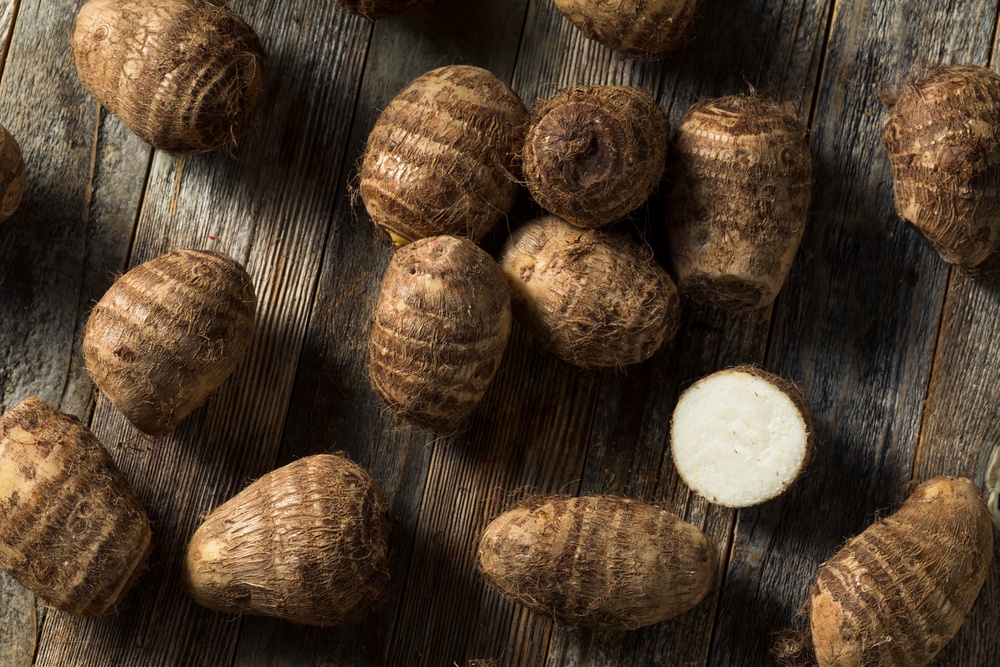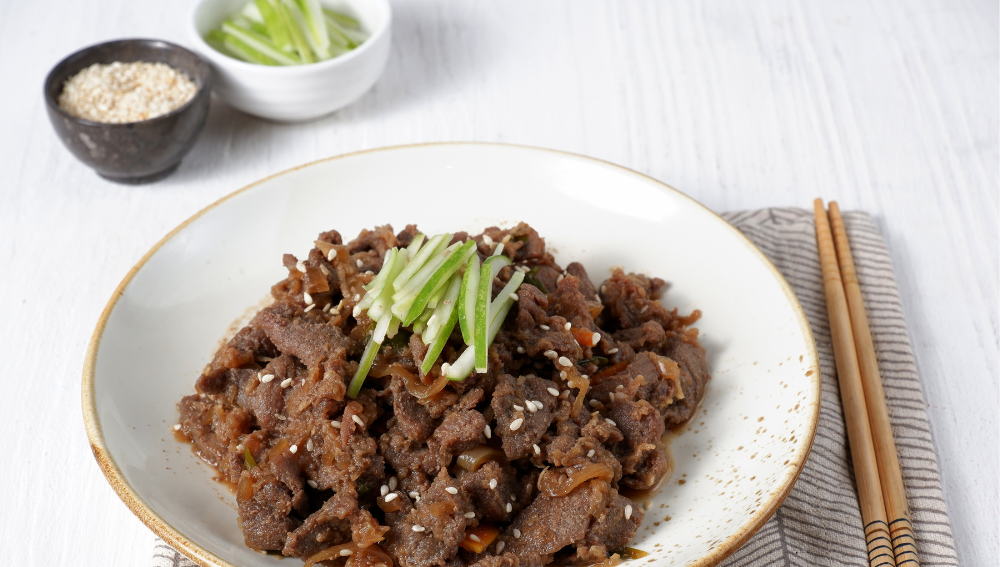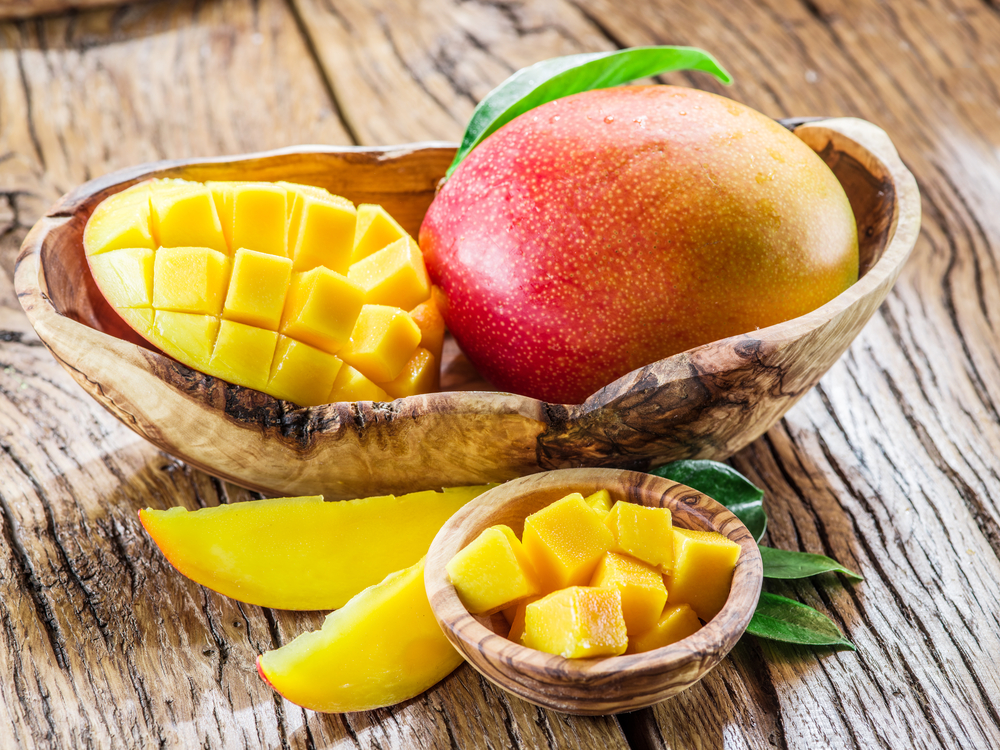As someone who has tried durian before, I can tell you that it is a fruit unlike any other. Durian is a tropical fruit that is native to Southeast Asia and is often referred to as the “king of fruits” due to its large size and unique flavor.
Despite its popularity in many Asian countries, durian’s pungent aroma and unusual taste can be off-putting to those who are not familiar with it.
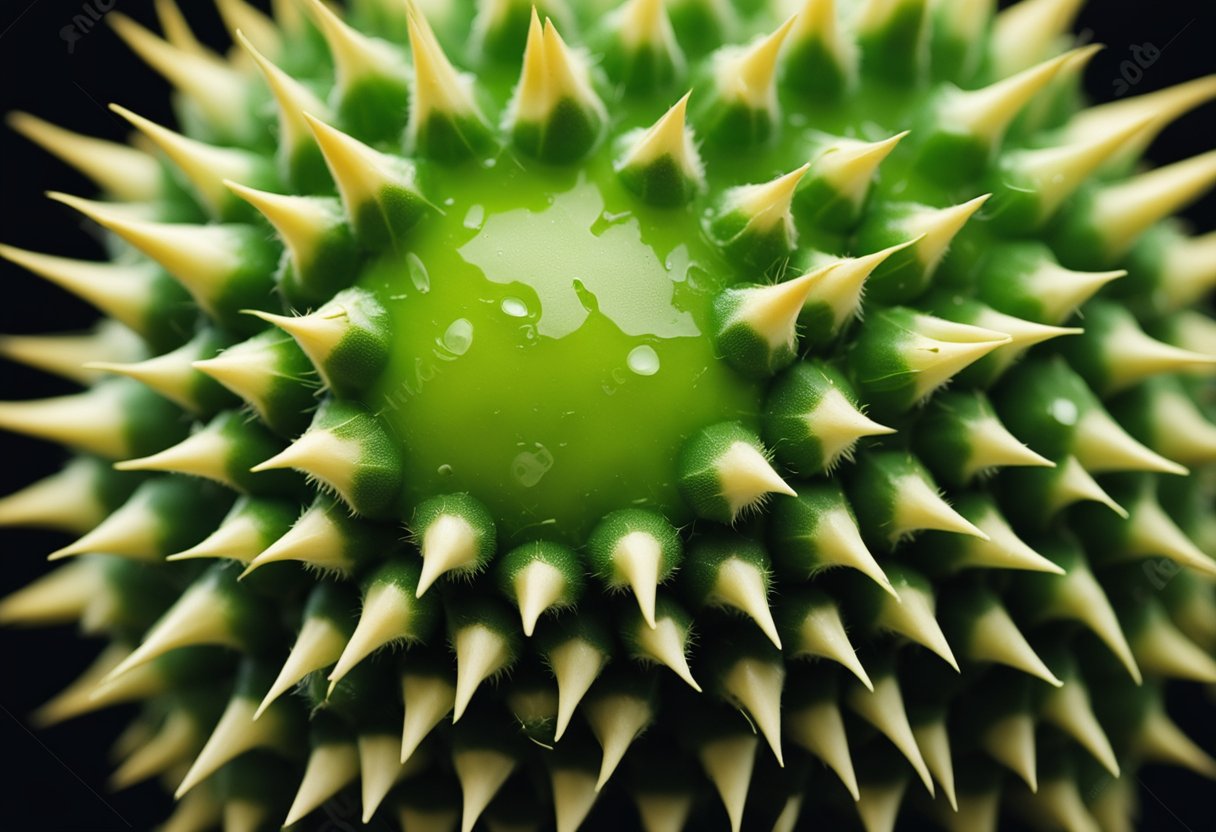
So, what does durian taste like? The taste of durian is often described as a combination of sweet, savory, and slightly bitter flavors.
Some people compare the taste to that of custard or cheesecake, while others say it has a nutty or garlic-like flavor. However, what sets durian apart from other fruits is its texture.
When ripe, the flesh of the fruit is creamy and custard-like, but it also has a slightly fibrous texture that can take some getting used to.
Key Takeaways
- Durian is a unique tropical fruit native to Southeast Asia that is often referred to as the “king of fruits.”
- The taste of durian is a combination of sweet, savory, and slightly bitter flavors with a creamy, custard-like texture.
- Despite its popularity in many Asian countries, durian’s pungent aroma and unusual taste can be off-putting to those who are not familiar with it.
What is Durian?
As someone who has tasted durian, I can confidently say that it is a unique fruit that is loved by some and hated by others.
Durian is a tropical fruit that is native to Southeast Asia, particularly Malaysia, Thailand, and Indonesia. It is known as the “King of Fruits” due to its large size and distinctive flavor.
Durian is a large, spiky fruit that grows on trees. The fruit can weigh up to 7 pounds and is usually green or brown in color. The flesh of the fruit is creamy and yellow, with large seeds in the center.
The taste of durian is difficult to describe, as it is a complex mix of flavors. Some people describe it as sweet and creamy, while others say it is bitter and pungent.
Despite its unique taste, durian is a popular fruit in Southeast Asia. It is used in a variety of dishes, including desserts, snacks, and even main courses. In Malaysia, durian is often used to flavor ice cream, while in Thailand, it is used in curry dishes.
In addition to its distinctive flavor, durian is also known for its strong odor. Some people compare the smell of durian to rotten eggs or even sewage. This strong odor has led to durian being banned in some public places, such as hotels and airports.
Overall, durian is a fascinating fruit that is worth trying if you have the opportunity. While its taste and smell may not be for everyone, it is an important part of Southeast Asian cuisine and culture.
Physical Attributes of Durian
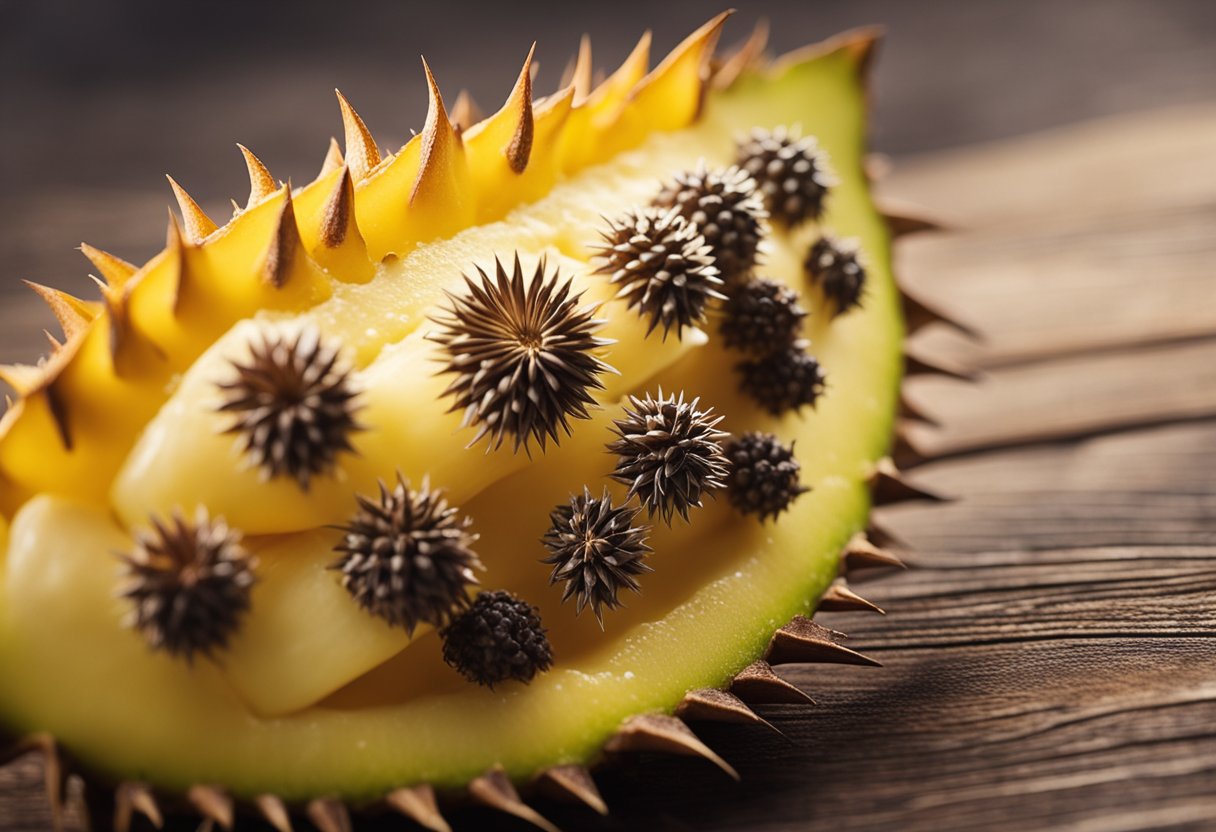
As someone who has tasted durian before, I can confidently say that it is a unique and unforgettable fruit. Its physical attributes are just as distinctive as its taste and smell.
Firstly, the durian fruit itself is quite large, typically weighing between 1 to 3 kilograms. It has a spiky, hard outer skin that ranges in color from green to brownish-yellow, depending on its ripeness.
The spikes are sharp and can be dangerous if not handled properly.
When the durian fruit is ripe, its flesh is a creamy yellow color and is soft and custard-like in texture. The flesh is divided into segments, with each segment containing a large seed.
The seeds are covered in a thin layer of fibrous material that is not meant to be eaten.
The taste of durian is difficult to describe, but it is often described as a combination of sweet, savory, and slightly bitter.
The texture of the flesh is also unique, with some people describing it as being similar to custard or pudding, while others describe it as being fibrous or stringy.
When the durian fruit is unripe, its flesh is much harder and has a more sour taste. The skin of an unripe durian is also much harder and more difficult to open.
In summary, the physical attributes of durian include a large, spiky, hard outer skin that protects a creamy yellow, custard-like flesh divided into segments containing large seeds.
The taste and texture of the flesh are unique and difficult to describe, with the fruit being sweet, savory, and slightly bitter. The unripe fruit is harder and sour in taste, with a harder skin that is more difficult to open.
Taste and Texture of Durian
Durian is a unique fruit that is known for its strong odor and distinct taste. The taste of durian is often described as sweet, creamy, and custard-like, with notes of caramel and butter.
The texture of durian is soft and creamy, with a slight chewiness that is similar to custard.
When you first taste durian, you will notice its sweetness. Almost all durians have a strong noticeable sweetness in them.
In fact, most durians will have sweetness as the dominating taste that engulfs a person’s mouth when he or she bites into the aril. Some of the cultivars famous for their intense sweetness are IOI, D13, and Monthong.
Durian also has a slight bitterness to it, which can be more noticeable in some varieties than others. The bitterness is often described as being similar to the taste of almonds.
Some people argue that the bitterness and sweetness of durian are perfectly balanced, while others find the bitterness to be overpowering.
In addition to its sweetness and bitterness, durian has a floral flavor that is similar to the taste of jasmine or rose. This floral flavor is more noticeable in some varieties than others.
The creaminess of durian is one of its most distinctive features. The flesh of the fruit is uniquely tender and creamy, with a custard-like texture that is unlike any other fruit.
Some people describe the creaminess of durian as being similar to the texture of butter or whipped cream.
Overall, the taste and texture of durian is a complex and unique experience. While some people love the taste of durian, others find it to be too strong or overpowering.
If you have never tried durian before, it is definitely worth giving it a try to see if you enjoy its distinctive taste and texture.
Durian’s Aroma
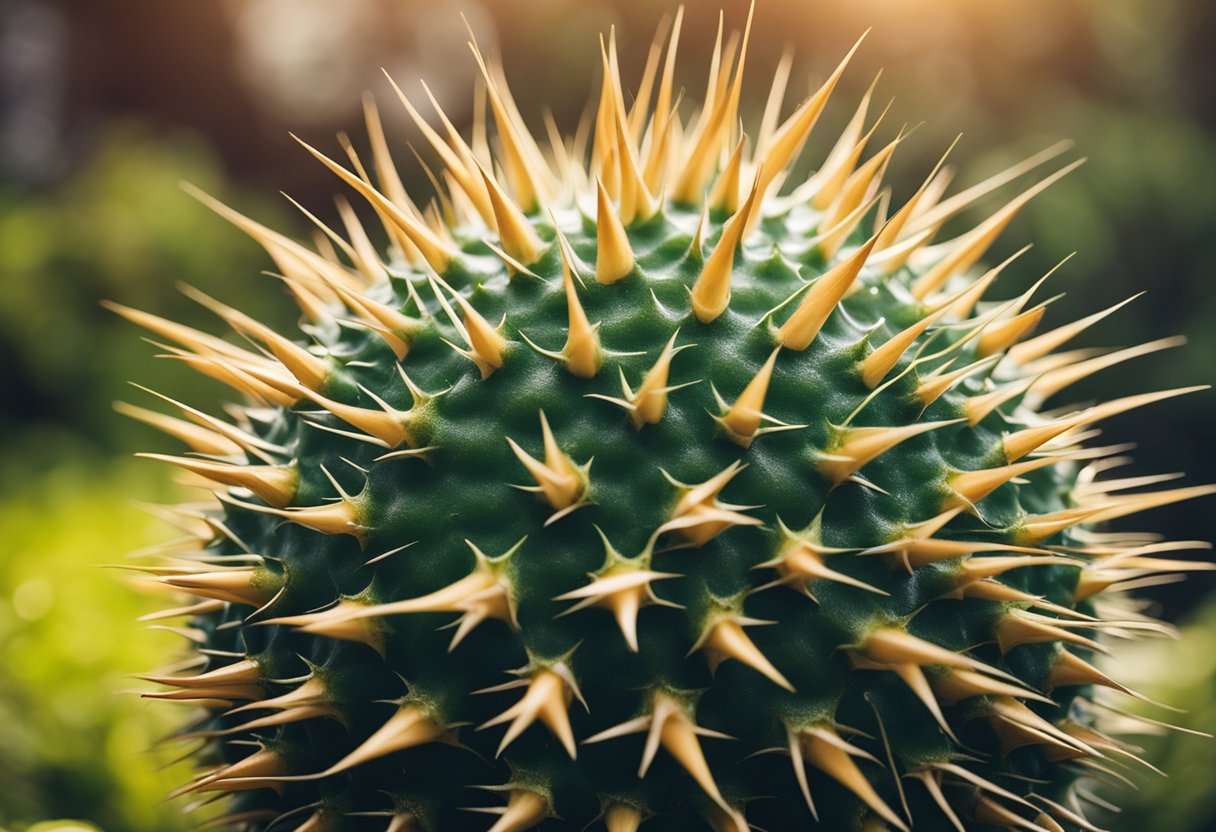
As someone who has tasted durian before, I can confidently say that the fruit’s aroma is one of its most distinctive features. The smell of durian has been described in many ways, with some people finding it intolerable and others enjoying it.
The most common comparison for the smell of durian is to that of rotten onions or sewage. However, it’s important to note that this is not an entirely accurate description.
While the smell of durian is certainly strong and potent, it’s not necessarily unpleasant to everyone.
In fact, some people find the aroma of durian to be quite appealing. It’s been described as having a sweet, fruity scent that is similar to custard or almonds.
However, this is not the case for everyone, and many people find the smell of durian to be overpowering and intolerable.
It’s worth noting that the smell of durian can linger for quite some time, even after the fruit has been removed from the room. This is why it’s often banned from public transportation and hotels in certain parts of the world.
Overall, the aroma of durian is a key part of its identity as a fruit. Whether you love it or hate it, there’s no denying that the smell of durian is one of the most distinct and memorable scents in the world of food.
Culinary Uses of Durian

Durian is a versatile fruit that can be used in many culinary applications. Its unique flavor and texture make it a popular ingredient in Southeast Asian cuisine. Here are some of the most common culinary uses of durian:
Eat it Fresh
The most common way to enjoy durian is to eat it fresh. Simply cut open the fruit and remove the flesh from the seed.
The flesh can be eaten raw or cooked, depending on your preference. Some people like to sprinkle salt on the flesh to enhance the flavor.
Use it in Cakes and Ice Cream
Durian is a popular ingredient in cakes and ice cream. Its creamy texture and sweet flavor make it a great addition to desserts.
Durian cake is a popular dessert in Southeast Asia, and can be found in many bakeries and restaurants. Durian ice cream is also a popular dessert, and can be found in many ice cream shops.
Cook it in Curries
Durian can also be used in savory dishes, such as curries. Its unique flavor adds depth to curries, and the creamy texture of the flesh helps to thicken the sauce. Durian curry is a popular dish in Malaysia and Indonesia.
Add it to Smoothies and Yogurt
Durian can be blended into smoothies or added to yogurt for a healthy and delicious snack. Its sweet flavor pairs well with other fruits, such as mango and banana.
Try Durian Recipes
There are many recipes that feature durian as the main ingredient. Durian sticky rice is a popular dessert in Thailand, and durian pancakes are a popular breakfast food in Malaysia. Durian can also be used in savory dishes, such as durian fried rice.
Overall, durian is a versatile fruit that can be used in many different culinary applications. Its unique flavor and texture make it a popular ingredient in Southeast Asian cuisine.
Durian Varieties
As I explore the taste of durian, it’s important to note that there are various types of durian available in the market. Each variety has its own unique flavor and texture that sets it apart from others. Here are some of the most popular durian varieties:
Mao Shan Wang
Mao Shan Wang is one of the most famous durian varieties. It has a creamy and rich texture with a bittersweet taste.
Its flesh is yellowish in color, and it has a strong aroma that can be overpowering for some. Mao Shan Wang is often considered the king of durians and is highly sought after by durian lovers.
D13
D13 is another popular durian variety that has a sweet and creamy taste. Its flesh is pale yellow in color, and it has a mild aroma compared to other durian varieties.
D13 is often used in desserts and is a popular choice among durian lovers who prefer a milder taste.
D24
D24 is a durian variety that has a creamy and smooth texture with a sweet and slightly bitter taste. Its flesh is yellowish in color, and it has a strong aroma that can be overpowering for some.
D24 is often used in desserts and is a popular choice among durian lovers who prefer a sweeter taste.
Other Types of Durian
Apart from Mao Shan Wang, D13, and D24, there are many other types of durian available in the market. Some of the other popular durian varieties include Black Thorn, Red Prawn, and Golden Phoenix.
Each of these varieties has its own unique flavor and texture that makes it a favorite among durian lovers.
In conclusion, there are many different varieties of durian available in the market, each with its own unique taste and texture.
Whether you prefer a sweet or bitter taste, there is a durian variety out there that will suit your taste buds.
Storing and Handling Durian
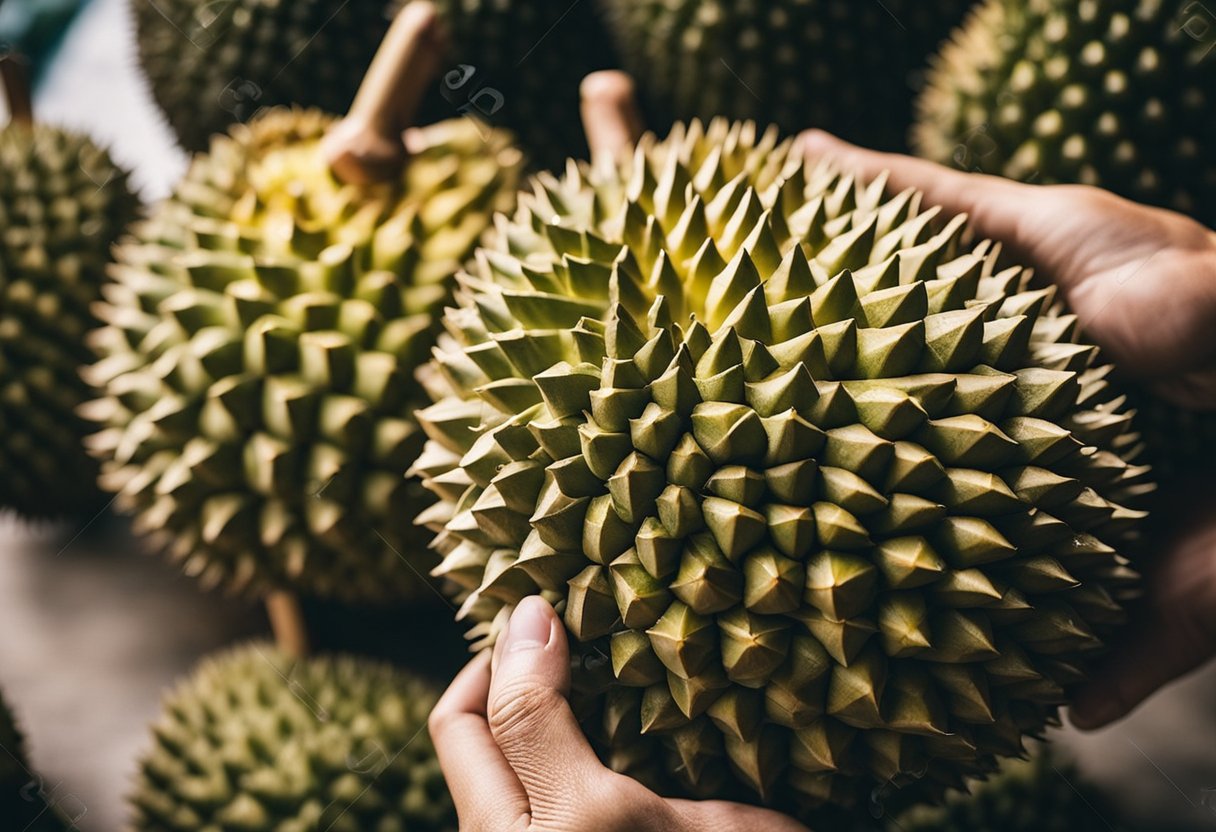
As a durian enthusiast, I know that storing and handling durian properly is crucial to preserving its unique flavor and aroma. Here are some tips on how to store durian:
- Store at room temperature: Durian should be stored at room temperature for a few days to allow it to ripen. Make sure to keep it away from direct sunlight and heat sources.
- Refrigerate once ripe: Once the durian is ripe, it can be stored in the refrigerator to prolong its shelf life. Place it in an airtight container to prevent the strong aroma from spreading to other foods in the fridge.
- Freeze for long-term storage: If you want to store durian for an extended period, you can freeze it. Cut the durian into smaller pieces and place them in a freezer-safe container. Durian can be stored in the freezer for up to three months.
When handling durian, it’s essential to be careful as the fruit has a spiky exterior. Here are some tips on how to handle durian:
- Wear gloves: To avoid getting pricked by the spikes, wear gloves when handling durian.
- Cut it open carefully: Use a sharp knife to cut the durian open. Cut along the natural ridges of the fruit and be careful not to cut yourself.
- Remove the flesh gently: Once the durian is cut open, remove the flesh gently using your fingers or a spoon. Be careful not to damage the seeds, which can be roasted and eaten.
In conclusion, storing and handling durian properly is essential to preserve its unique flavor and aroma. By following these tips, you can enjoy durian at its best.
Buying Durian
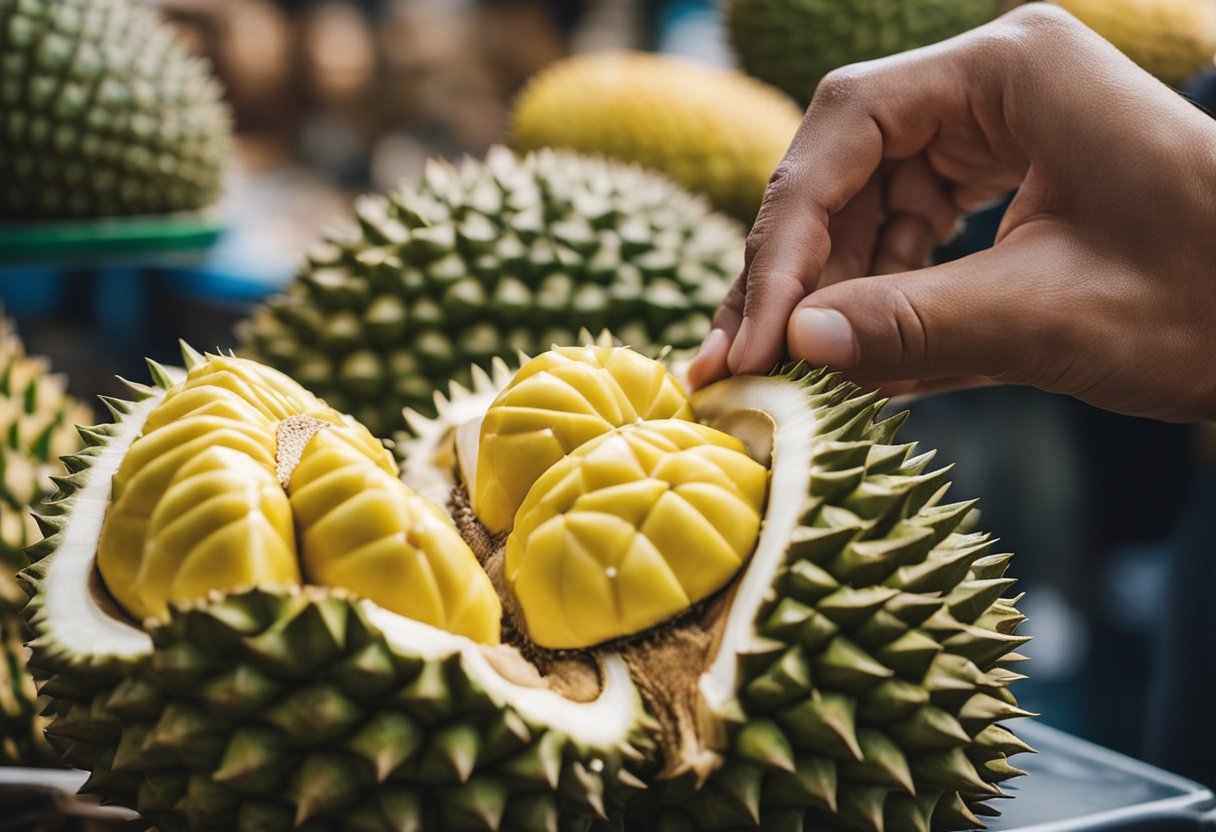
When it comes to buying durian, it’s important to know what to look for to ensure you get the best quality fruit.
As someone who has bought durian from various Asian markets and grocery stores, I have some tips that can help you make an informed decision.
Firstly, it’s important to note that durian is a seasonal fruit, so it may not be available all year round. In general, the durian season runs from June to August, but this can vary depending on the region.
So, if you’re looking to buy fresh durian, it’s best to do so during this time.
When buying durian, it’s important to use your senses. Look for a durian with a thick, spiky shell that is intact and free from any cracks or bruises. The stem should also be intact and not broken.
A good durian should also have a strong, sweet aroma, which is a sign that the fruit is ripe. However, be aware that the smell can be quite pungent and overpowering for some people.
If you’re unsure about how to pick a good durian, don’t be afraid to ask for help. Many Asian markets and grocery stores have staff who are knowledgeable about durian and can help you select a good one.
Some stores even offer samples, so you can taste the fruit before you buy it.
In terms of where to buy durian, Asian markets are a good place to start. These markets often have a wide variety of durian to choose from, including different varieties and grades.
However, durian can also be found at some specialty grocery stores or online.
Overall, buying durian can be a bit intimidating for those who are unfamiliar with the fruit. But by using your senses, asking for help, and shopping at the right places, you can ensure that you get a good quality durian that tastes delicious.
Durian in Different Cultures
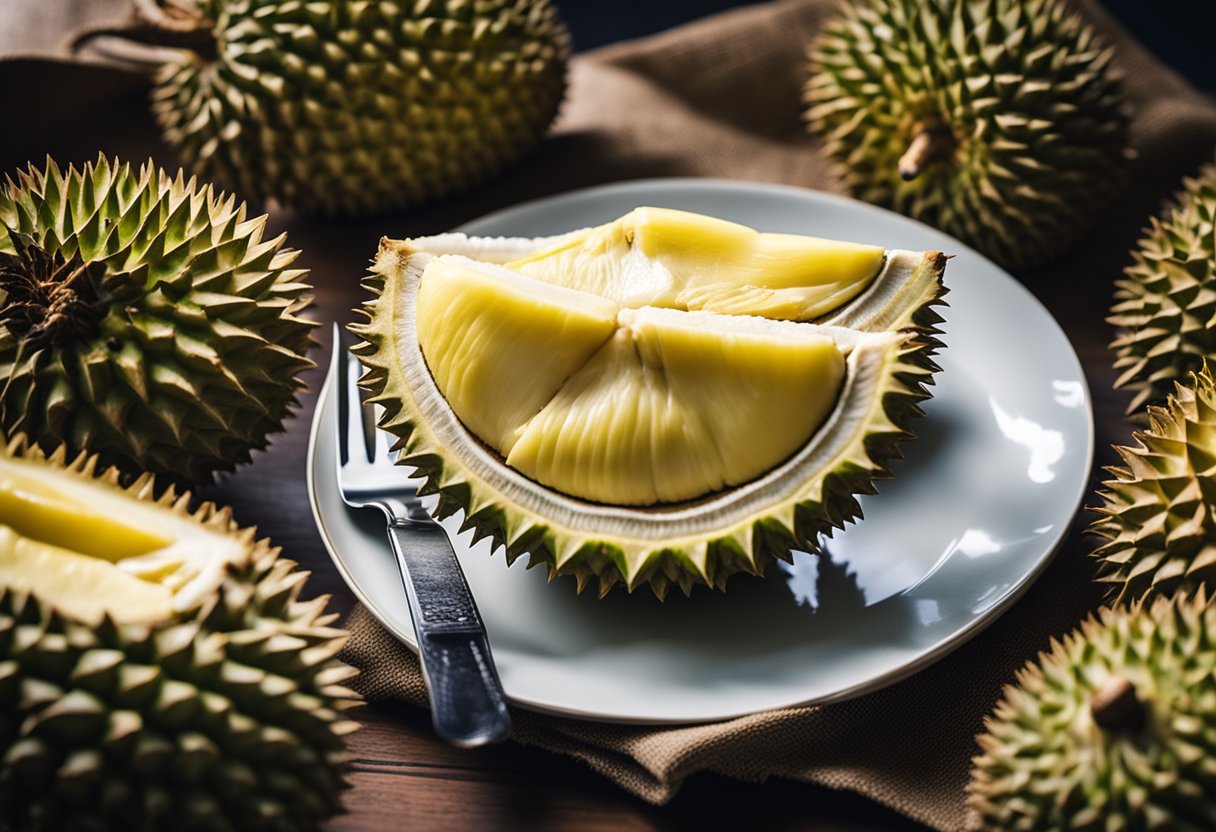
Durian is a fruit that is widely consumed in Southeast Asia, particularly in Malaysia, Thailand, and Indonesia. In these countries, durian is considered a delicacy and is often enjoyed fresh or used as an ingredient in various dishes.
Durian is also popular in Singapore, where it is often served in desserts and drinks.
In the United States, durian is not as well-known or widely consumed. However, it can still be found in some specialty grocery stores and Asian markets.
Some people in the United States may be hesitant to try durian due to its strong odor, which has been compared to the smell of gym socks, rotten eggs, or even sewage.
Despite its popularity in Southeast Asia, durian is not always welcome in public transport or subways. In fact, some countries have banned durian from public transport due to its strong smell, which can be overpowering in enclosed spaces.
In Malaysia, durian is often referred to as the “King of Fruits” due to its unique flavor and texture. Malaysians enjoy durian in a variety of ways, including eating it fresh, using it as an ingredient in desserts, and even making durian-flavored ice cream.
In Thailand, durian is known as “thu-rian” and is often used in savory dishes such as curries and soups. Thai people also enjoy durian as a sweet snack or dessert.
In Indonesia, durian is a popular fruit that is often enjoyed fresh or used in desserts. Indonesians also use durian in traditional medicine, believing that it has various health benefits.
Overall, durian is a unique and flavorful fruit that is enjoyed by many people in Southeast Asia and beyond.
While its strong smell may be off-putting to some, those who are brave enough to try it may be pleasantly surprised by its rich, custard-like flavor.
Nutritional Value of Durian

As a nutritionist, I always emphasize the importance of incorporating nutrient-dense foods into our diets. Durian is a unique fruit that is known for its strong smell and taste.
It is native to Southeast Asia and is considered a delicacy in many countries. In this section, I will outline the nutritional value of durian and why it is a great addition to a healthy diet.
Vitamins and Minerals
Durian is a rich source of vitamins and minerals. One cup of chopped fresh or frozen durian (243g) provides 357 calories, 3.6g of protein, 66g of carbohydrates, and 13g of fat.
It is a great source of potassium, phosphorus, magnesium, vitamin C, and folate. According to the USDA, one cup of durian contains:
- Calories: 357
- Fat: 13g
- Sodium: 4.9mg
- Carbohydrates: 66g
- Fiber: 9.2g
- Protein: 3.6g
- Potassium: 1059mg
- Phosphorus: 106mg
- Magnesium: 76mg
- Vitamin C: 80.8mg
- Folate: 137mcg
Antioxidants
Durian is also a great source of antioxidants, which are compounds that protect the body against free radicals and oxidative stress.
These antioxidants include vitamin C, carotenoids, and flavonoids, which have been linked to a reduced risk of chronic diseases such as cancer, diabetes, and heart disease.
Other Nutrients
In addition to vitamins, minerals, and antioxidants, durian also contains other important nutrients such as:
- Calcium: Durian contains a small amount of calcium, which is important for bone health.
- Iron: Durian contains a small amount of iron, which is important for the production of red blood cells.
- B vitamins: Durian contains several B vitamins, including thiamin, riboflavin, and niacin, which are important for energy production and overall health.
Overall, durian is a nutrient-dense fruit that is packed with vitamins, minerals, and antioxidants. It is a great addition to a healthy diet and can provide numerous health benefits.
Eating Durian
When it comes to eating durian, there are a few things to keep in mind. First of all, you need to decide whether you want to eat it raw or cooked.
Raw durian is the most common way to eat it, and it’s also the way to get the full experience of its unique flavor and texture.
To eat raw durian, you’ll need to cut it open and remove the flesh from the seeds. The flesh is soft and creamy, with a custard-like texture that’s both sweet and savory.
Some people describe the flavor as being similar to vanilla or butterscotch, while others say it’s more like a mix of onion and garlic.
One thing to keep in mind is that durian has a very strong odor, which can be off-putting to some people. If you’re not used to the smell, it can be overwhelming at first.
However, once you get past the smell, the flavor of the fruit is definitely worth trying.
If you’re not a fan of the strong smell, you can also try cooking durian. When cooked, the smell is less intense, and the flavor is more subdued.
Some popular ways to cook durian include making durian pancakes, durian ice cream, or adding it to curries and other savory dishes.
Overall, eating durian is a unique experience that’s definitely worth trying at least once. Whether you eat it raw or cooked, the flavor and texture are unlike anything else out there.
Just be prepared for the strong smell, and keep an open mind when it comes to the taste.
Durian’s Reputation
As an AI language model, I have not tasted durian, but I have gathered information from various sources about what durian tastes like. Durian is a fruit with a distinct reputation that precedes it.
It is known for its strong odor, which has been described as a mix of rotten eggs, garlic, onions, and even sewage. The smell is so strong that it is often banned from public transportation and hotels.
The fruit’s reputation is not just limited to its smell. Durian is also known to be an expensive fruit, with prices varying depending on the season and location. In some countries, it is considered a luxury item and is often given as a gift.
When it comes to the taste of durian, opinions are divided. Some people find it to be unpleasant, while others enjoy it. The texture of the fruit is creamy and custard-like, with a sweet flavor that has been compared to a mix of banana, vanilla, and almond.
Despite its divisive taste, durian has gained popularity in Southeast Asia, where it is used in various dishes and desserts. In fact, durian is so popular that there are durian-themed festivals and events held in some countries.
Overall, durian’s reputation is one of strong smells, high prices, and divisive taste. While some people enjoy it, others find it intolerable.
Frequently Asked Questions
What are the different varieties of durian?
There are over 30 different varieties of durian, each with its own unique taste and texture. Some popular varieties include D24, Musang King, XO, and Red Prawn.
What are the health benefits of durian?
Durian is a good source of fiber, vitamin C, potassium, and folate. It also contains antioxidants and has been shown to have anti-inflammatory properties. However, it is also high in calories and sugar, so it should be consumed in moderation.
How do you eat durian?
To eat durian, first, use a sharp knife to cut open the spiky outer shell. Then, use your hands to separate the edible flesh from the seeds. Some people prefer to eat it fresh, while others like to cook with it or use it in desserts.
Is the smell of durian appealing to everyone?
No, the smell of durian is notoriously strong and pungent, and it is not appealing to everyone. In fact, some people find the smell so unpleasant that it has been banned from public transportation and hotels in some countries.
What is the reason behind the strong smell of durian?
The strong smell of durian is caused by a combination of volatile sulfur compounds, which are similar to the compounds found in onions and garlic. These compounds are also responsible for the fruit’s distinctive taste.
What are some fruits similar to durian?
There are no fruits that are exactly like durian, but some fruits that have been compared to it include jackfruit, breadfruit, and soursop. These fruits are all tropical and have a similar texture and flavor profile to durian.





